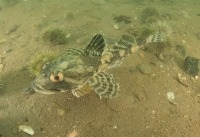
(Photo: Claire Goodwin)
Longhorn Sculpin
Myxoxocephalus octodecemspinosus
This fish has a large head and its body tapers to a relatively narrow caudal peduncle. It reaches up to 46 centimetres in length, but they are usually less than 35 centimetres. Its colour varies with its surroundings. It has an overall colour of dark olive to greenish-yellow with darker crossbars or blotches. It can be distinguished from the very similar shorthorn sculpin (Myoxocephalus scorpius) by its uppermost cheek spine which reaches back to at least the edge of its gill cover.
Authority
(Mitchill, 1814)
Classification Details
Phylum: Chordata (chordates); Subphylum: Vertebrata (vertebrates); Class: Actinopterygii (ray-finned fishes).
Habitat
Found in the northwest Atlantic from Virginia, USA, to eastern Newfoundland, Canada. Found to 190 m. Usually present in shallow coastal waters but move into deeper waters in winter.
Diet
Scavenger and predator feeding on a wide variety of food. Prey includes juvenile fish, shrimps, crabs, crustaceans, worms, hydroids and ascidians.
Reproduction
Sexes are separate, and fertilization is external. Spawning takes place from November to January. The average female deposits around 8 000 eggs. Females lay their sticky eggs masses in clumps on the seabed, on shells, or amongst the branches of sponges. Larvae stay in the plankton for over a month.
Fun Facts
The longhorn sculpin’s long spines deter other fish from eating it. In one study of the stomachs of predatory fish, scientists found that less than 1% contained longhorn sculpin.
The longhorn sculpin survives in icy waters by making antifreeze for its blood. Seawater can get down to -1.9°C without freezing, but the plasma of unprotected fish blood freezes at 0.7°C. Antifreeze proteins bind to ice crystals and stop them growing.
References
Davies PL, Hew CL, Fletcher GL (1988) Fish antifreeze proteins: physiology and evolutionary biology. Canadian Journal of Zoology 66: 2611-2617. DFO (2008) St. Mary’s Bay Longhorn sculpin (Myoxocephalus octodecemspinosus) assessment. Canadian Science Advisory Secretariat Science Advisory Report 2008/051 Froese R and Pauly D (2020). FishBase. Myoxocephalus octodecemspinosis (Mitchill, 1814), Longhorn sculpin. https://www.fishbase.se/summary/4120 Accessed online 19 June 2020. Scott WB and Scott MG (1988) Atlantic fishes of Canada. Canadian Bulletin of Fisheries and Aquatic Sciences 219, 731p.

